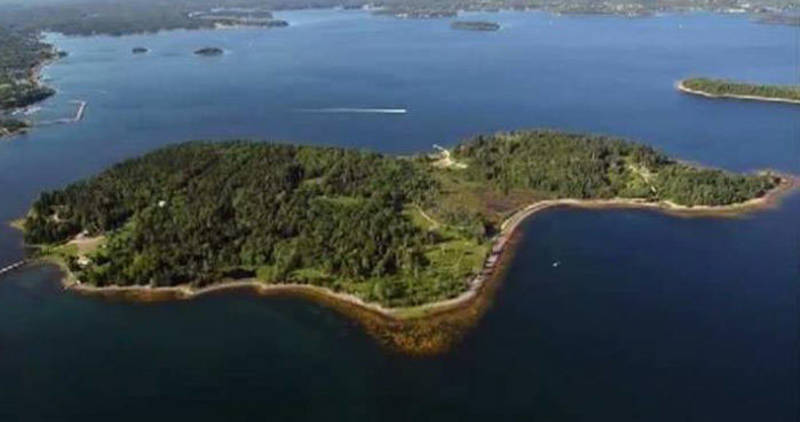We love TV show #TheCurseOfOakIsland which is about one of #NovaScotia's greatest mysteries! Here is a #geological take on the treasure hunt that highlights the searchers' challenge in figuring out what really happened on #OakIsland.
#nspoli #NS
@CurseOfOak
@HISTORY
#nspoli #NS
@CurseOfOak
@HISTORY

Like many islands in #MahoneBay, #NovaScotia, #OakIsland is a #drumlin - rock, sand, gravel and clay deposited by glaciers as the last ice age ended
about 12,000 years ago. Actually, the island is 4 connected drumlins.
#nspoli #NS
@CurseOfOak
@HISTORY
about 12,000 years ago. Actually, the island is 4 connected drumlins.
#nspoli #NS
@CurseOfOak
@HISTORY

Because #OakIsland is #drumlins, it may have layers of #gravel below sea
level which could explain the flood tunnel mystery. Searcher shafts might
just be intersecting sea water naturally flowing underground through porous gravel.
#nspoli #NS
@CurseOfOak
@HISTORY #NovaScotia
level which could explain the flood tunnel mystery. Searcher shafts might
just be intersecting sea water naturally flowing underground through porous gravel.
#nspoli #NS
@CurseOfOak
@HISTORY #NovaScotia

Background info about the Oak Island mystery is at oakislandtours.ca.
More on the island's geology tomorrow....
More on the island's geology tomorrow....
#OakIsland's eastern bedrock, where the #MoneyPit is located, is #limestone
and #gypsum. They are soft rocks that often erode in groundwater, creating
natural tunnels and cavities. Some of the underground "workings" could be
naturally-occurring.
#nspoli #NS
@CurseOfOak
@HISTORY
and #gypsum. They are soft rocks that often erode in groundwater, creating
natural tunnels and cavities. Some of the underground "workings" could be
naturally-occurring.
#nspoli #NS
@CurseOfOak
@HISTORY

For example, in 1878 the Cave-in Pit was discovered on #OakIsland when oxen
plowing a field fell into a large hole. It might have been a
naturally-occurring sinkhole. #NovaScotia has many sinkholes caused by
erosion of soft #minerals like #gypsum.
#nspoli #NS
@CurseOfOak
@HISTORY
plowing a field fell into a large hole. It might have been a
naturally-occurring sinkhole. #NovaScotia has many sinkholes caused by
erosion of soft #minerals like #gypsum.
#nspoli #NS
@CurseOfOak
@HISTORY

#OakIsland was connected to the mainland until rising sea levels, caused by
melted #glaciers, made it an island 1000 years ago. Sea levels are much lower
during ice ages because water is frozen in glaciers.
#TheCurseOfOakIsland
#nspoli #NovaScotia #NS
@CurseOfOak
@HISTORY
melted #glaciers, made it an island 1000 years ago. Sea levels are much lower
during ice ages because water is frozen in glaciers.
#TheCurseOfOakIsland
#nspoli #NovaScotia #NS
@CurseOfOak
@HISTORY

Sea levels around #NovaScotia 200-300 years ago were about 1.5 metres lower
than today. This would make it impossible to float and sink a ship in the
triangular swamp, as one #OakIsland theory suggests.
#TheCurseOfOakIsland
#nspoli #NS
@CurseOfOak
@HISTORY
than today. This would make it impossible to float and sink a ship in the
triangular swamp, as one #OakIsland theory suggests.
#TheCurseOfOakIsland
#nspoli #NS
@CurseOfOak
@HISTORY

While #geology may explain some of #OakIsland's mysteries, there is lots
that it can't. Why is coconut fiber there? Whose bones were found deep
underground? Who left the lead cross? Keep watching to find out!
#TheCurseOfOakIsland
#nspoli #NovaScotia #NS
@CurseOfOak
@HISTORY
that it can't. Why is coconut fiber there? Whose bones were found deep
underground? Who left the lead cross? Keep watching to find out!
#TheCurseOfOakIsland
#nspoli #NovaScotia #NS
@CurseOfOak
@HISTORY

• • •
Missing some Tweet in this thread? You can try to
force a refresh



























